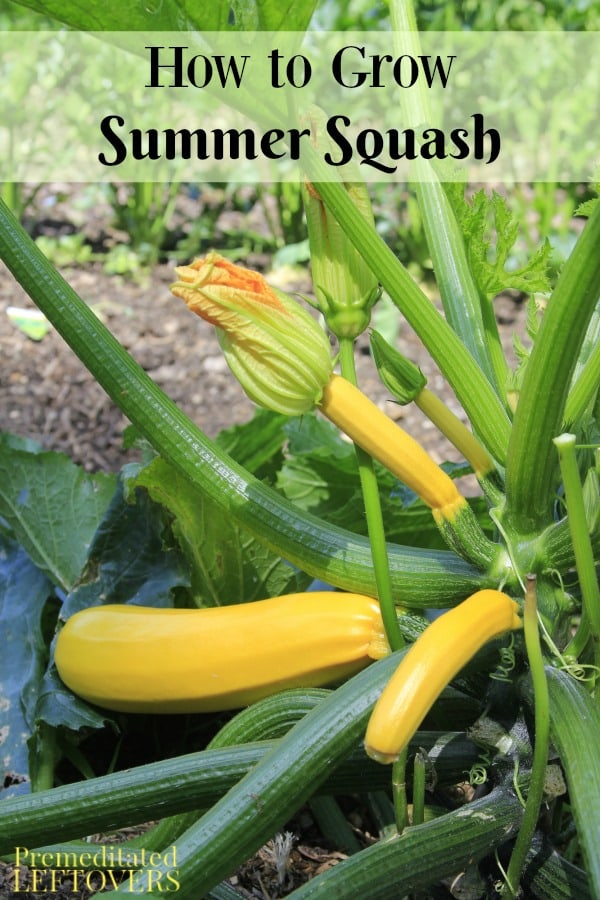Here is a quick guide for how to grow summer squash from seed to harvest.

Do you love eating fresh summer squash? Many people do, which is why it is a summertime garden favorite. If you are considering growing squash in your garden this season, or just want to improve your crop from last year, take a look below at tips on how to grow summer squash. You will find by following a few simple steps, growing an abundance of summer squash can be quite easy. Here is how to get started.
How to Grow Summer Squash
How to plant squash seeds
Starting squash seeds indoors is an option. You want to begin them 3-4 weeks before the final frost of the season. If you do opt to start them indoors, plant them in starters that can be transplanted along with them. Otherwise, the roots may become damaged in the process.
Whether starting indoors or directly outside, choose soil that is moist yet well drained. Squash will also appreciate full sun. Plant seeds one inch deep and 18-24 inches apart. If you wish, you can plant using a hill method, where you make a small hill and add a few seeds per hill. This method is advised if it is still chilly when planting season arrives.
Growing squash in containers can be a challenge and it is not typically advised. Should you decide you want to try, you need a deep container that can handle the far stretching roots. You would also be wise to use a trellis system to encourage the plant to grow upwards.
How to transplant your squash seedlings
Squash seedlings have incredibly long roots. Because of this, you want to start or purchase plants in biodegradable pots. This way, the roots can stay safe in the pot when you plant. Be sure that your planting hole is at least 6 inches deep so the roots have plenty of room to stretch. Loose soil that isn’t full of clay or compacted is also advised.
Mulch can help keep the squash plants moist and can help keep weeds at bay. Mulch along with 1-2 inches of water per week will keep your squash plants happy and flourishing.
How to care for your squash plants
Because the roots are deep, plan on watering once or twice a week for lengthy periods. You want the water to have the chance to work its way down to the deepest of roots. Feel free to fertilize several weeks into planting should the squash need a little boost. If it appears to be bright and flourishing, you can skip fertilizing.
Aphids and stink bugs like to dine on squash plants. Mist your plants with a mixture of water and dish soap (just a few drops of soap will do) to help repel the bugs and protect your plants. This is a wonderful method that eliminates the need for any chemical solutions.
Should you see any rot or discoloration set in, check your plants for pests and then make sure you are not over or under watering. Remember that 1-2 inches per week is sufficient, and best received by the plant when given all at once.
When and how to harvest squash
Like zucchini, bigger isn’t better when it comes to squash. You want to pick it when it is of modest size, about 6 inches in length. Pick the vegetable as close to the stem as possible. Once picked be gentle with the vegetable as it can bruise easily. If refrigerated, squash can last up to two weeks.
Squash can be prepared in so many ways. It is great for grilling and of course using in shish-ka-bobs. If you can’t get enough squash during the summer months, give these growing tips a try and see what you can achieve.
More Vegetable Growing Tips
- How to Grow Zucchini
- Tips for Growing Peas
- Tips for Growing Spinach
- Tips for Growing Cabbage
- Tips for Growing Parsnips
- How to Grow Radishes
- Tips for Growing Swiss Chard
- Tips for Growing Brussels Sprouts
- Tips for Growing Heirloom Tomatoes
- Tips for Growing Kale in Your Garden
- Secrets to Growing Summer Squash
- Tips for Growing Arugula in Your Garden
- Tips for Growing Broccoli in Your Garden
- Tips for Growing Beets in Your Garden
- Tips for Growing Cauliflower in Your Garden
- Tips for Growing Kohlrabi in Your Garden
- Tips for Growing Carrots in Your Garden
- How to Grow Eggplant


Monica says
Do you need to prune them. My plants are huge. With giant ice stems and leabes.
Katherine says
What could the reason be for the fruit not growing? Females are present but not grow bigger than an average pinky finger.